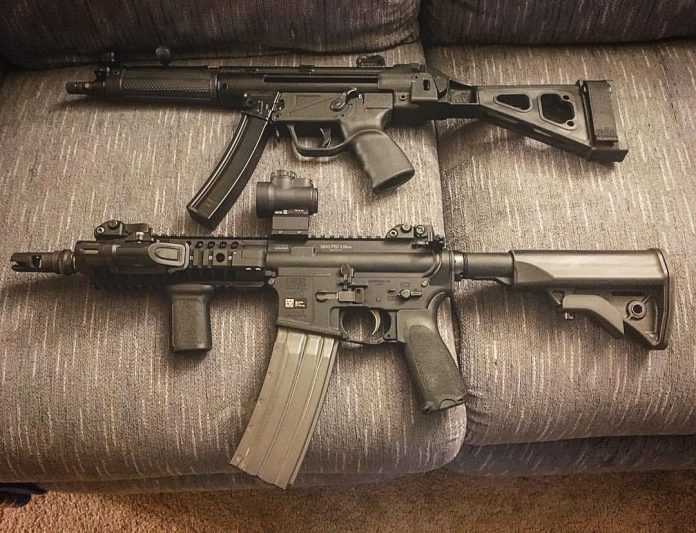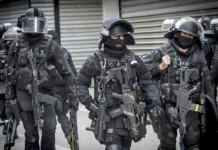
We’ve been hitting the digital ink hard on the roll-out of the “Frame and Receiver” rule (which still isn’t published yet) and while I’m refreshing regulations.gov to see when they publish the rule format of ATF-2021-0001-0001 I looked at a publication on braces. Braces were ATF-2021-0002-0002 and how the braced firearm circumvents the NFA and GCA is the topic.
This is where we run into the clash of the NFA’s absurdity and the intent of the law vs. how a law can be applied. Rules must become increasingly more convoluted to encompass ever increasing complexity and nuance. They become more and more vague while promising they will finally solve this problem.
All of this predicates on the false premise that these particular firearms are more suitable for crime (based entirely off of the text of the NFA) than other firearms. This premise is evidentiary false, as criminal misuse of firearms tend to factor around price (cheap enough) and convenience of acquisition (illicit purchase or theft) and considers the physical capabilities of the firearm a distant third. Hell, if we consider the Frame and Receiver ruleset premise it throws the brace premise off balance. Many of the braced pistols are expensive examples of firearms and their popularity is in that it avoids additional expense and wait times while providing a nearly identical product to the taxable one. Heck, the tax may be paid afterwards in the more expedient fashion of the Form 1 instead of the Form 4.
The brace “problem” is entirely of the ATF’s creation, their inability to process rudimentary paperwork that the law mandates in a timely manner created the off design demand that the pistol brace is often purchased to fill. People don’t mind the tax or the background check overly much, it was the waiting that fueled this current ‘nightmare’ of alleged NFA violations.
This all dismissed the mountain of evidence that since all these violations have occurred, and crime has still trended along the lines of affordability and convenience more than capability, that the NFA was in error that these firearms are particularly criminally suited. They are merely firearms and should hold no special place above a handgun.
Preliminary Regulatory Analysis and Initial Regulatory Flexibility Analysis
There was a supporting document submitted with the rule proposal. You can find it here. It was covers the proposed rule from the Office of Regulatory Affairs. It covers the scope of the rule’s impacts financially and covers the estimated efforts required for implementation.
It shows, in short, it will be a nightmare to implement.
The ‘Need for Regulatory Action’ on Pg. 14. is where the tale really begins.
1.2 Need for Federal Regulatory Action
One of the reasons ATF is considering the proposed rule is the failure of the market to
compensate for negative externalities caused by commercial activity. A negative externality can
be the by-product of a transaction between two parties that is not accounted for in the
transaction. A negative externality addressed by this rule is that individuals and affected entities
may try to use purported “stabilizing braces” and affix them to firearms to circumvent the
requirements of the NFA, which requires registration and taxes to be paid on the making and
transfer of NFA weapons. Further, Congress chose to regulate these items more stringently,
finding them to be especially dangerous to the community if not regulated since they are used for
violence and criminal activity. See United States v. Gonzalez, No. 2:10-cr-00967, 2011 WL
5288727, at *5 (D. Utah Nov. 2, 2011) (“Congress specifically found that ‘short-barreled rifles
are primarily weapons of war and have no appropriate sporting use or use for personal
protection.’” (quoting S. Rep. No. 90-1501, at 28 (1968)). Therefore, if persons can circumvent
the NFA by effectively making unregistered short-barreled rifles by using an accessory, such as a
“stabilizing brace,” these weapons can continue to proliferate and could pose an increased public
safety problem given that they are easily concealable.
The reason the rule “needs” to be implemented goes all the way back to the GCA’s and NFA’s false presumptions that a shorter rifle is not suitable for individual civilian ownership and can therefore only further criminal activity. This is nonsense, even prior to the considering of the use evidence. Any number of experts in the firearm and law enforcement spaces could attest that the premise is garbage logic made up to support the rule to “do something” about violence. It did, and does, nothing substantial.
The differences between an AR-15 with a “permanent” muzzle device that makes the barrel 16″ in overall length and one in which that same muzzle device is merely tensioned on to the design specifications is nothing. But legally one is a normal rifle and the other is a crime enabling death machine. It is asinine.
The capability and lethality of the firearm is unchanged in any way, shape, or form. The round expelled from the muzzle will be traveling with identical (within manufacturing variance) speed and energy. The “concealability” of the weapon is the same, and even changing the length of a gun by upwards of 10 inches won’t change the portability and concealability of a roughly 7lb weapon by that much. The ways to hide a 40″ long M16 sized rifle all apply to the MK18 sized short barreled rifle, and vice versa. The M16 sized rifle is not superiorly suitable for citizen home defense and sporting use compared to the MK18, and arguably less so than the MK18 in many applications and more so in others.
It cannot be blanketly declared that short gun bad, long gun good.
It’s such a stupid declaration.
The M4 is a perfect example. The FN Military collector M4 is a good rifle only because the flash hider doesn’t come off easily. That is it. That is the difference between good gun and bad gun, one muzzle comes off with a wrench while the other has a weld and pin you have to take off and then use the wrench.
The practical truth is that all semi-auto and repeater style firearms (lever guns, magazine fed bolt guns, and revolvers included) occupy the same general threat profile as each other. I will call these ISA, Individual Small Arm, threats. While the capabilities in scale to each other can be different from a 9mm subcompact handgun to a 7.62×51 NATO chambered rifle, the threat to the public of man or woman armed with a firearm is roughly the same. The publicly funded response to this threat is roughly the same, cops wearing protective gear interdict.
The amount of damage a threat inflicts is determined by the environmental availability of targets, target selection criteria, and appear of effective counter force. Nothing whatsoever matters about barrel length or the legal inclusion of a stock for the threat profile we are talking about. They don’t matter, we know they don’t matter. We have seen the evidence again and again that the lethal power dynamic starts at armed and motivated assailant vs. unarmed and unprepared target, and that is all that is necessary to inflict substantial casualties. Not a 16″ barrel vs. a 15.9″ because 15.9″ was more concealable. Not even 16″ vs. 8″ barrel makes much difference, not in the scale of the efficacy of an attack.
No one with two brain cells to rub together is looking at Mandalay Bay or Pulse and saying, “good thing those barrels weren’t shorter.”
(Gues)stimates
The ATF stated they believed between 3 and 7 million brace units were on the market, making or intended to make SBR and SBS firearms.
Meanwhile, the Congressional Research Service (CRS) estimates between 10 million and 40 million units. How is it that the ATF’s highest estimate and lowest estimate from Congress are so disparate? How is the minimum estimate from Congress 42% higher than the maximum estimate out of the ATF?
There isn’t any overlap in the estimates. None.
How?
Could the ATF be artificially depressing the number to lower the amount of ‘estimated’ commercial and legal impact the rule change would have? We’re talking a 571% difference in the top end estimates. If we apply that rate of change to the projected costs this quickly becomes a nearly $2,000,000,000.00 ($2 Billion) dollar project. So who’s math sucks here? I’m betting Congress has the more accurate number, and I’d also put money on it being closer to 40 than 10.
However, in lieu of promulgating a proposed regulation, ATF has used and will continue
to use enforcement actions, to include criminal actions, against existing FFLs that manufacture
firearms that do not comply with the intent of the law. Since 2013, ATF has brought 3 actions
against manufacturers of firearms with “stabilizing braces” that do not comply with the intent of
the law. Those actions have not been concluded. ATF estimates that in the absence of this
proposed rule, these individual enforcement actions against existing FFLs would change the
market perception of these “stabilizing braces” and may affect the overall demand for these items
regardless of the implementation of the proposed rule. Therefore, ATF estimates that the overall
future demands of “stabilizing braces” would be less than it has been in the recent past, even in
the absence of the publication of this proposed rule. For the purposes of this analysis, ATF
estimates that the overall future demand for “stabilizing braces” would decrease overall since
Type 1 and Type 7 FFLs would no longer carry firearms with these “stabilizing braces” attached,
making the primary estimate of future “stabilizing braces” 211,178 per year.
So the ATF’s plan is to bully FFLs into “compliance” with the NFA instead of acknowledging and adjusting the false premise the rules are built upon, that these firearms are more dangerous than others. Instead of adjusting the NFA, or removing it entirely as a failed effort, the efforts are to double down on the dumpster fire and keeping making the rules harder to follow and be more vague.
It was the rules, or rather the time involved in following them, that caused this “problem” in the first place. Instead of tackling that issue and making following the rule non-problematic, the ATF is looking to add another questionably enforceable layer of dubious efficacy.
Overall, ATF anticipates that this proposed rule would affect the manufacturers of these
“stabilizing braces”; Type 1 FFL dealers who sell either “stabilizing braces” or the completed
firearm with an attached “stabilizing brace”; Type 7 FFL manufacturers who attach these
“stabilizing braces” to their firearms and sell them as a completed firearm with a “stabilizing
brace”; and individuals who have either purchased these “stabilizing braces” and attached them
to existing firearms or individuals who have purchased a firearm with an attached “stabilizing
brace.” Based on SME estimates, ATF estimates that 25 percent of Type 1 and Type 7 FFLs
would be affected by this proposed rule. Based on ATF licensing numbers, there are 52,840
Type 1 FFLs, of which 13,210 would be affected. Based on the same licensing numbers, there
are 15,524 Type 7 FFLs, of which 3,881 would be affected.
Just like their previously absurdly low estimate of braces, the percentage of FFLs affected feels low. Very low. I haven’t seen or heard of a shop that won’t deal in braced firearms if they are legal to begin with in the state. So perhaps a raw percentage is a terrible measure and we should be filtering by more stringent criteria? Maybe we exclude FFLs where the firearms aren’t sold per the law? Perhaps we filter the information by manufacturers’ percentage of affected products and volume of those products sold to gauge popularity? Possibly even add on projected demand and backorder information and add price filtering to see where these are going. Within that price filtering in place, let’s compare that to braced firearms used in crimes. Then compare that to firearms in general used in crimes.
What? That would make it look like cheap and available guns are the ones used most often in crimes?
Amazing. Who would have thought…
This is just to Pg. 17 in the analysis.
There are several pages of cost analysis showing that this is expensive and labor intensive. On page 41 begins the stated benefits.
This proposed rule is intended to affect attempts by manufacturers and individuals to
circumvent the requirements of the NFA and affect the criminal use of weapons with a purported
“stabilizing brace,” such as the shooting incident at the King Soopers in Boulder, Colorado. The
purpose of this proposed rule is to amend ATF regulations to clarify when a rifle is “intended to
be fired from the shoulder” and to set forth factors that ATF considers when evaluating firearms
with an attached purported “stabilizing brace” to determine whether these are “rifles” under the
GCA or NFA, and therefore whether they are “firearms” subject to the NFA. Congress placed
stricter requirements on the making and possession of short-barreled rifles because it found them
to pose a significant crime problem. Providing clarity to the public and industry on how ATF
enforces the provisions of the NFA through this proposed rule is intended to significantly
enhance public safety and could reduce the criminal use of such firearms, which are easily
concealable from the public and first responders. ATF invites comment on how to quantify the
expected effect of the proposed rule on public safety risk and how to monetize the benefits of
this effect.
Again, we are at the “found to pose a significant crime problem” being just thrown into the open as a foregone conclusion. No critical analysis applied. I wonder if this finding by congress was based upon some of those ‘Gun Control Studies‘ with a 99.6% failure rate in their data collection methodology. The conclusions taken from those studies would then be highly suspect since the studies were suspect. But we keep going back to, “Congress found (meaning “said”) they are bad.” as the justification. No effort made to examine whether that premise is true, just Congress setting the demonstrably false baseline.
The only thing accurate about the statement is that braces are being used by some purchasers to avoid the NFA provisions.
Why? Perhaps because my last SBR purchase took 13 months to complete, and I am not a unique case by any means, maybe that is why? I literally got an FFL and an SOT for my company here in the time it took to clear my SBR for transfer. Sure, it makes sense for the business to have one. We actually went and got it because of NFA wait times though. That was the trigger. The law was such a pain we chose to spend money to avoid the wait time again.
We have that option, we’re a firearm related business. The average consumer neither would or should be subject to needing the full annual costs of licensure just to avoid an atrocious wait time for a product, all in the absurf name of safety and crime prevention. Yep, so many crimes prevented by making folks wait a year and spend an extra $200 on a background check they can have conducted at the sales counter of their gun store.
You solved crime ATF. Gold sticky star for you.
Wait…
“ATF invites comment on how to quantify the expected effect of the proposed rule on public safety risk and how to monetize the benefits of this effect.“
They don’t have a clue how to measure whether or not this will have any positive effect… at all… anywhere… and they want to spend, and cost the industry, hundreds of millions of dollars to do it anyway. Instead of pushing to remove the source of the issue and streamline the pain points in the law, just over complicate it further.
Oh, and on the NFA Tax forgiveness…
This alternative would allow individuals and entities that currently have firearms with
attached “stabilizing braces” to apply under the NFA without paying the $200 making tax. In
this scenario, the societal costs would be the same except there would be no transfer payment.
Similar to the proposed rule, the bulk of this cost would be the forgone future revenue and the
loss in property for individuals not applying under the NFA. This scenario was rejected
because “stabilizing braces” are not serialized and an individual or entity could merely register
all firearms possessed with the intent of later obtaining a “stabilizing brace.” Further, although
used on a particular weapon, an individual might register all pistols as SBRs and then attempt to
utilize other stocks on these firearms. ATF requests additional comments about the feasibility of
providing tax forgiveness. ATF also request information on how this would affect your decision
to use this scenario under this proposed rule.
So they won’t exempt your stabilizing braces because then you could just put a regular stock on it instead. You gotta pay! Can’t make this workable and just accept the flood of SBRs for a window, knowing not all of them would have been previously braced firearms but making them all NFA compliant. That would again make too much sense and actually solve some of the pressures being exerted on problematic compliance concerns.
So there it is folks, the Brace rule information. It’s still bad too, but Biden didn’t signal it was done so perhaps they are still working on making it better… or worse… probably worse.



